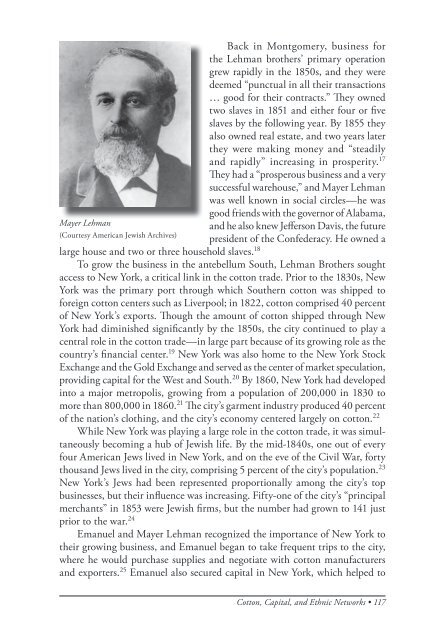American Jewish Archives Journal, Volume 64, Numbers 1 & 2
American Jewish Archives Journal, Volume 64, Numbers 1 & 2
American Jewish Archives Journal, Volume 64, Numbers 1 & 2
Create successful ePaper yourself
Turn your PDF publications into a flip-book with our unique Google optimized e-Paper software.
Back in Montgomery, business for<br />
the Lehman brothers’ primary operation<br />
grew rapidly in the 1850s, and they were<br />
deemed “punctual in all their transactions<br />
… good for their contracts.” They owned<br />
two slaves in 1851 and either four or five<br />
slaves by the following year. By 1855 they<br />
also owned real estate, and two years later<br />
they were making money and “steadily<br />
and rapidly” increasing in prosperity. 17<br />
They had a “prosperous business and a very<br />
successful warehouse,” and Mayer Lehman<br />
was well known in social circles—he was<br />
good friends with the governor of Alabama,<br />
and he also knew Jefferson Davis, the future<br />
president of the Confederacy. He owned a<br />
large house and two or three household slaves. 18<br />
To grow the business in the antebellum South, Lehman Brothers sought<br />
access to New York, a critical link in the cotton trade. Prior to the 1830s, New<br />
York was the primary port through which Southern cotton was shipped to<br />
foreign cotton centers such as Liverpool; in 1822, cotton comprised 40 percent<br />
of New York’s exports. Though the amount of cotton shipped through New<br />
York had diminished significantly by the 1850s, the city continued to play a<br />
central role in the cotton trade—in large part because of its growing role as the<br />
country’s financial center. 19 New York was also home to the New York Stock<br />
Exchange and the Gold Exchange and served as the center of market speculation,<br />
providing capital for the West and South. 20 By 1860, New York had developed<br />
into a major metropolis, growing from a population of 200,000 in 1830 to<br />
more than 800,000 in 1860. 21 The city’s garment industry produced 40 percent<br />
of the nation’s clothing, and the city’s economy centered largely on cotton. 22<br />
While New York was playing a large role in the cotton trade, it was simultaneously<br />
becoming a hub of <strong>Jewish</strong> life. By the mid-1840s, one out of every<br />
four <strong>American</strong> Jews lived in New York, and on the eve of the Civil War, forty<br />
thousand Jews lived in the city, comprising 5 percent of the city’s population. 23<br />
New York’s Jews had been represented proportionally among the city’s top<br />
businesses, but their influence was increasing. Fifty-one of the city’s “principal<br />
merchants” in 1853 were <strong>Jewish</strong> firms, but the number had grown to 141 just<br />
prior to the war. 24<br />
Emanuel and Mayer Lehman recognized the importance of New York to<br />
their growing business, and Emanuel began to take frequent trips to the city,<br />
where he would purchase supplies and negotiate with cotton manufacturers<br />
and exporters. 25 Mayer Lehman<br />
(Courtesy <strong>American</strong> <strong>Jewish</strong> <strong>Archives</strong>)<br />
Emanuel also secured capital in New York, which helped to<br />
Cotton, Capital, and Ethnic Networks • 117
















